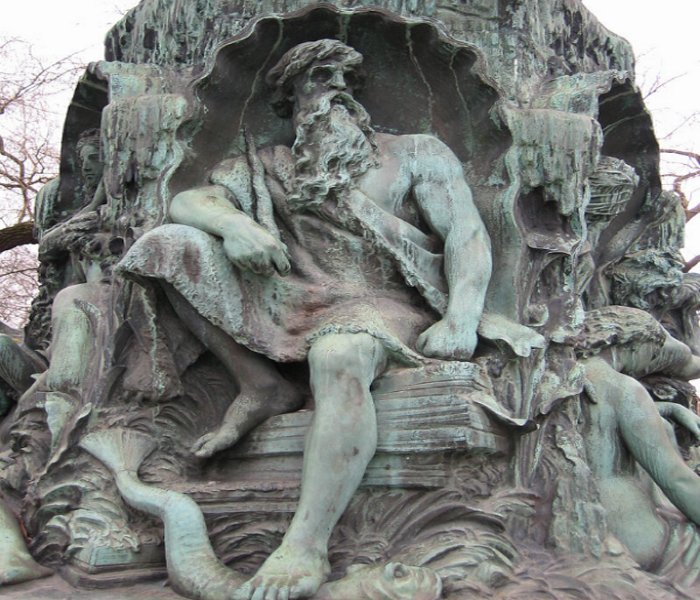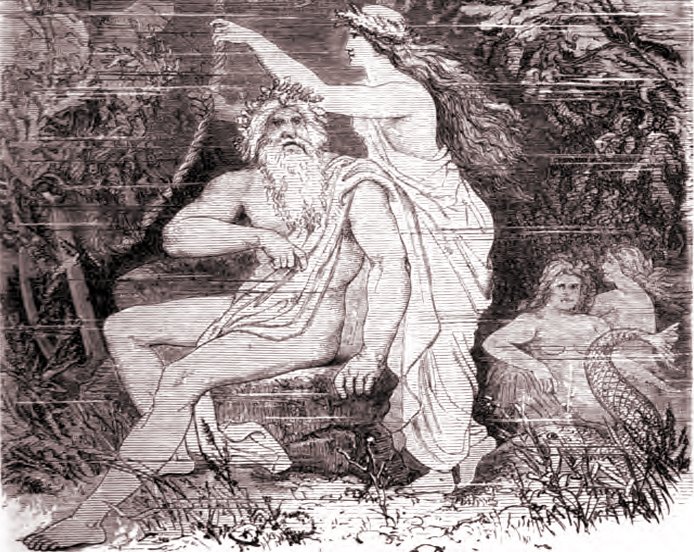Aegir – Jotun Lord Of The Stormy Seas Revered And Feared By Norsemen
A. Sutherland - AncientPages.com - In Norse mythology, Aegir (Ægir) was the ancient jotun lord of the sea, who belonged to a primeval order of gods, predating the Aesir, the Vanir, and the giants, dwarfs, and elves.
“Aegir and Ran.” Aegir sits and rests his arm on a stone, while his wife Ran pulls on a rope connected to an anchor. Mermaids lounge in the background. Friedrich Wilhelm Heine (1845-1921) after an original by Friedrich Wilhelm Engelhard (1813-1902)
Fathered by the great giant Ymir, Aegir was considered omnipotent within his realm. He was the one who existed before them, and he would survive long after they died.
Aegir was usually portrayed as an older man with long white hair and clawlike hands. He lived in a great hall in coral caves beneath the island of Hlesey, (probably the island of Laeso ("Isle of Hlér" "Island of Hlér,") which is the largest island in the North Sea bay of Kattegat, Denmark.
He was a personification of the ocean, often compared to the 'greedy destroyer' in the poetry of seamen and sailors.
In legends of the Anglo-Saxon people, the sea god Aegir was known as 'Eagor.' He was known as Hler ('the shelterer') among the Northern nations and Gymir ('the concealer'). He was a good friend of the Aesir gods, and according to legend, Aegir and Ran organized exquisite underwater banquets for drowned men and gods in the depths of the sea.
However, it was not always so.
 Fountain of JP Molin at Kungsträdgården in Stockholm, 1866. Image credit: Hedning - CC BY-SA 3.0
Fountain of JP Molin at Kungsträdgården in Stockholm, 1866. Image credit: Hedning - CC BY-SA 3.0
"At first, he was no friend of the Aesir. Thor, however, intimidating him with piercing eyes, constrained him to give a banquet for the gods each winter in his own hall; later, he, in turn, paid visits to the Aesir, who received him in a friendly manner. His banquets were in very truth merrymakings, at which ale flowed of its own accord; his hall was lighted by gleaming gold instead of candles; his brisk serving men, Eldir and Fimafeng, ministered to the guests…" 1
In his 'Skáldskaparmál' (or 'language of poetry'), the second part of the Younger Edda, Snorri Sturluson says that Aegir lived with his sister-wife, Ran. The couple had two servants, Eldir and Fimafeng, and nine beautiful giantess daughters (the Wave Maidens) who wore veils and white robes.
The nine daughters of Aegir were his foster mothers. Number nine was of great importance for ancient cultures and their beliefs. It was Odin who mated with them simultaneously to produce Heimdallr, who guarded Asgard and illuminated the world.
There were nine muses, and Hydra, the mythological monster, had nine heads. During the Han Dynasty, cosmology was based on the number nine for a time prevalent Sheol - "nine sources" - The Abode of the Dead. It was believed that Nine Unknown Men were guardians of forbidden knowledge hidden from humanity. In Chinese beliefs, Phoenix was the nine-headed bird ("Jiu Feng"), a monster in Chinese mythology.
There was a time when the Vikings, the masters of the sea, believed in Njord, Aegir, and his wife, Ran. Njord was responsible for the sea near the shore, the wind off the sea, fishing, and trade. His duty was also to calm down dangerous storms created far out at sea by Aegir.
Aegir was revered and feared by sailors experiencing furious storms on the sea. They believed that Aegir – usually angry and hostile - would occasionally appear suddenly to take ships, boats, men, and cargo with him to his underwater domain at the bottom of the ocean.
Ran was even more dangerous; she used to lurk behind the ice masses and was always ready to attack suddenly. She used a net to entrap seafarers from the decks of their ships. She was frequently seen drowning sailors and pulling them down to a grave beneath the sea's waves, where she ruled with her husband, Aegir.
Ran was believed to be the goddess of death for all who vanished at sea. One legend has it that sailor who died might reappear at their funeral feasts if the goddess Ran was particularly eager to give them hospitality in her halls. Seamen who went overboard bearing gold were particularly welcomed by Ran, who loved gold because it lighted her underwater realm.
Even if they were not her favorites, she wasn't unfriendly. As at Odin's Valhalla, the mead was served at will in the halls of the goddess Ran.
Aegir was a divine ruler of the sea. Ancient people associated with the sea depended on him and his terrible mood. Their faith in Aegir was based on fear; the crews of merchant and fishing boats usually had to navigate far from the shore and home.
They needed a safe journey across the sea; nobody had to remind them that they should always plead to Aegir.
Written by - A. Sutherland - AncientPages.com Senior Staff Writer
Updated on February 5, 2023
Copyright © AncientPages.com All rights reserved. This material may not be published, broadcast, rewritten or redistributed in whole or part without the express written permission of AncientPages.com
Expand for referencesReferences:
H. R. Ellis Davidson in 'Gods and Myths of Northern Europe'
Guerber H. A. Myths of the Norsemen: From the Eddas and Sagas
More From Ancient Pages
-
 More Greek Gods’ Heads And A Life-Sized Statue Of A Man Unearthed In The Ancient City Of Aizanoi
Archaeology | Dec 28, 2022
More Greek Gods’ Heads And A Life-Sized Statue Of A Man Unearthed In The Ancient City Of Aizanoi
Archaeology | Dec 28, 2022 -
 Abydos: One Of The Most Important Cities Of Ancient Egypt
Civilizations | Jul 15, 2016
Abydos: One Of The Most Important Cities Of Ancient Egypt
Civilizations | Jul 15, 2016 -
 Enigma Of The Mysterious Ancient Shining Twins – Were They With Humans From The Beginning Of History? Part 1
Featured Stories | Jun 6, 2020
Enigma Of The Mysterious Ancient Shining Twins – Were They With Humans From The Beginning Of History? Part 1
Featured Stories | Jun 6, 2020 -
 Calçoene – Amazon Stonehenge And The Mysterious Amapán Megalithic Culture
Civilizations | Feb 14, 2018
Calçoene – Amazon Stonehenge And The Mysterious Amapán Megalithic Culture
Civilizations | Feb 14, 2018 -
 Effects Of The Volcanic Eruption In Alaska Rippled Through Ancient Egypt During Cleopatra’s Reign
Archaeology | Jul 26, 2022
Effects Of The Volcanic Eruption In Alaska Rippled Through Ancient Egypt During Cleopatra’s Reign
Archaeology | Jul 26, 2022 -
 Secret Ancient Knowledge Of The Toltecs Examined
Civilizations | Aug 16, 2019
Secret Ancient Knowledge Of The Toltecs Examined
Civilizations | Aug 16, 2019 -
 Mysterious Ancient Circular Structure Discovered In Turkey – Has Zippalanda, The Lost City Of The Hittites Been Found?
Archaeology | Dec 27, 2022
Mysterious Ancient Circular Structure Discovered In Turkey – Has Zippalanda, The Lost City Of The Hittites Been Found?
Archaeology | Dec 27, 2022 -
 Mysterious Mongolian Arc Investigated By Scientists
Archaeology | Jan 2, 2024
Mysterious Mongolian Arc Investigated By Scientists
Archaeology | Jan 2, 2024 -
 Why Are Statues Of Mythical Yeti Dividing People In The Himalayas?
Featured Stories | Feb 18, 2020
Why Are Statues Of Mythical Yeti Dividing People In The Himalayas?
Featured Stories | Feb 18, 2020 -
 Evidence Of Copper Processing Unearthed At Archaeological Site In Oman
Archaeology | Mar 6, 2024
Evidence Of Copper Processing Unearthed At Archaeological Site In Oman
Archaeology | Mar 6, 2024 -
 Archaeologists Reveal 12 Exciting Finds From The Gjellestad Viking Ship Dig
Archaeology | May 28, 2022
Archaeologists Reveal 12 Exciting Finds From The Gjellestad Viking Ship Dig
Archaeology | May 28, 2022 -
 Fossil Study: Coelacanths Thrived In Switzerland After A Mass Extinction
Fossils | Jul 28, 2023
Fossil Study: Coelacanths Thrived In Switzerland After A Mass Extinction
Fossils | Jul 28, 2023 -
 Denisovans Were First To Adapt To High Altitude And Harsh Conditions Of Tibetan Plateau
Archaeology | May 2, 2019
Denisovans Were First To Adapt To High Altitude And Harsh Conditions Of Tibetan Plateau
Archaeology | May 2, 2019 -
 Uncovering The Lost Indigenous Settlement Of Sarabay, Florida
Archaeology | Jun 9, 2021
Uncovering The Lost Indigenous Settlement Of Sarabay, Florida
Archaeology | Jun 9, 2021 -
 Long-Lost Anglo-Saxon Monastery Ruled By Queen Cynethryth Of Mercia Discovered By Archaeologists
Archaeology | Aug 19, 2021
Long-Lost Anglo-Saxon Monastery Ruled By Queen Cynethryth Of Mercia Discovered By Archaeologists
Archaeology | Aug 19, 2021 -
 Mysterious Ancient Structures Hidden Under The Sand In The Sahara Desert Could Re-Write History Of Ancient Egypt
Featured Stories | May 30, 2015
Mysterious Ancient Structures Hidden Under The Sand In The Sahara Desert Could Re-Write History Of Ancient Egypt
Featured Stories | May 30, 2015 -
 Abu Dhabi Fossil Dunes May Have Inspired The Ancient Great Flood Story – Professor Says
Archaeology | Jul 10, 2022
Abu Dhabi Fossil Dunes May Have Inspired The Ancient Great Flood Story – Professor Says
Archaeology | Jul 10, 2022 -
 Cave Hidden Under Pembroke Castle in Wales Could Hold Secrets Dating Back 10,000 Years
Archaeology | Jul 16, 2022
Cave Hidden Under Pembroke Castle in Wales Could Hold Secrets Dating Back 10,000 Years
Archaeology | Jul 16, 2022 -
 Massive Eruption Of Iceland’s Laki Volcano Triggered An Unusually Cold Winter In 1783-84
Archaeology | May 21, 2019
Massive Eruption Of Iceland’s Laki Volcano Triggered An Unusually Cold Winter In 1783-84
Archaeology | May 21, 2019 -
 Three Bronze Age Chariots, Shields, Daggers And Decorated Coffins Unearthed In Northern India
Archaeology | Jun 7, 2018
Three Bronze Age Chariots, Shields, Daggers And Decorated Coffins Unearthed In Northern India
Archaeology | Jun 7, 2018

